Kinematic and Physiological Analysis of Medieval Combat Sport Using Motion Analysis, Blood Lactate Measurement, and Heart Rate Monitoring: A Case Study
Abstract
1. Introduction
2. Methods for Analyzing Human Physical Responses
2.1. Human Motion Analysis Practice
2.2. Blood Lactate Level Measurement Approach
2.3. Heart Rate Monitoring Practice
3. Design of Study of the Medieval Combat Sport Combatant
3.1. Study Design
3.2. Description of the Participant
3.3. Experimental Procedure
3.4. Instrumentation
3.5. Experiment Design
3.6. Variables of the Study
3.7. Statistical Analysis of Kinematic Variables
4. Results
4.1. Motion Analysis
4.2. Blood Lactate Analysis
4.3. Heart Rate Analysis
5. Discussion and Implementation
Limitation and Future Work
6. Conclusions
Author Contributions
Funding
Institutional Review Board Statement
Informed Consent Statement
Data Availability Statement
Acknowledgments
Conflicts of Interest
References
- Kons, R.L.; Orssatto, L.B.R.; Detanico, D. Acute performance responses during repeated matches in combat sports: A systematic review. JSAMS J. Sci. Med. Sport 2020, 23, 512–518. [Google Scholar] [CrossRef] [PubMed]
- Li, F.; Rupčić, T.; Knjaz, D. The effect of fatigue on kinematics and kinetics of basketball dribbling with changes of direction. Kinesiology 2021, 53, 296–308. [Google Scholar] [CrossRef]
- Pavelka, R.; Třebický, V.; Fialová, J.T.; Zdobinský, A.; Coufalová, K.; Havlíček, J.; Tufano, J.J. Acute fatigue affects reaction times and reaction consistency in Mixed Martial Arts fighters. PLoS ONE 2020, 15, e0227675. [Google Scholar] [CrossRef] [PubMed]
- Sant’Ana, J.; Franchini, E.; da Silva, V.; Diefenthaeler, F. Effect of fatigue on reaction time, response time, performance time, and kick impact in taekwondo roundhouse kick. Sports Biomech. 2017, 16, 201–209. [Google Scholar] [CrossRef]
- Cynarski, W.J.; Wajs, W.; Vences Brito, A. Improving the movements of basic karate techniques with the use of motion capture and mathematical modeling. The concept of a research project. Ido Movement for Culture. J. Abbr. 2014, 14, 39–53. [Google Scholar] [CrossRef]
- Wasik, J.; Mosler, D.; Ortenburger, D.; Góra, T. Stereophotogrammetry measurement of kinematic target effect as speed accuracy benchmark indicator for kicking performance in martial arts. Acta Bioeng. Biomech. 2021, 23, 117–125. [Google Scholar] [CrossRef] [PubMed]
- Kaharuddin, M.Z.; Khairu Razak, S.B.; Kushairi, M.I.; Abd Rahman, M.S.; An, W.C.; Ngali, Z.; Siswanto, W.A.; Salleh, S.M.; Yusup, E.M. Biomechanics Analysis of Combat Sport (Silat) by Using Motion Capture System. In IOP Conference Series: Materials Science and Engineering; IOP Publishing: Bristol, UK, 2017; Volume 166, p. 012028. [Google Scholar] [CrossRef]
- VencesBrito, A.M.; Rodrigues Ferreira, M.A.; Cortes, N.; Fernandes, O.; Pezarat-Correia, P. Kinematic and electromyographic analyses of a karate punch. J. Electromyogr. Kinesiol. 2011, 21, 1023–1029. [Google Scholar] [CrossRef] [PubMed]
- Nitzsche, N.; Baumgärtel, L.; Maiwald, C.; Schulz, H. Reproducibility of blood lactate concentration rate under isokinetic force loads. Sports 2018, 6, 150. [Google Scholar] [CrossRef]
- Penumalla, S.; Katragadda, P.; Subash, Y.E. A study of lactate accumulation and changes in vital data during exercise on a bicycle ergometer. NJPPP Natl. J. Physiol. Pharm. Pharmacol. 2016, 6, 484–487. [Google Scholar] [CrossRef]
- Kessels, I.; Koopman, B.; Verdonschot, N.; Marra, M.; Gijsbertse, K. The added value of musculoskeletal simulation for the study of physical performance in military tasks. Sensors 2021, 21, 5588. [Google Scholar] [CrossRef]
- Djaoui, L.; Haddad, M.; Chamari, K.; Dellal, A. Monitoring training load and fatigue in soccer players with physiological markers. Physiol. Behav. 2017, 181, 86–94. [Google Scholar] [CrossRef] [PubMed]
- Damgrave, R.G.J.; Lutters, D. The drift of the Xsens Moven motion capturing suit during common movements in a working environment. In Competitive Design—Proceedings of the 19th CIRP Design Conference; Cranfield University: Bedford, UK, 2014; Volume 10, pp. 338–342. [Google Scholar]
- Skogstad, S.A.; Nymoen, K.; Høvin, M. Comparing inertial and optical MoCap technologies for synthesis control. In Proceedings of the 8th Sound and Music Computing Conference, Padova, Italy, 6–9 July2011; SMC: Stockholm, Sweden, 2011; pp. 2–7. [Google Scholar]
- Saber-Sheikh, K.; Bryant, E.C.; Glazzard, C.; Hamel, A.; Lee, R.Y.W. Feasibility of using inertial sensors to assess human movement. Man. Ther. 2010, 15, 122–125. [Google Scholar] [CrossRef] [PubMed]
- Seaman, A.; McPhee, J. Comparison of optical and inertial tracking of full golf swings. Procedia Eng. 2012, 34, 461–466. [Google Scholar] [CrossRef]
- Thies, S.B.; Tresadern, P.; Kenney, L.; Howard, D.; Goulermas, J.Y.; Smith, C.; Rigby, J. Comparison of linear accelerations from three measurement systems during “reach and grasp”. Med. Eng. Phys. 2007, 29, 967–972. [Google Scholar] [CrossRef] [PubMed]
- Canavan, P.K.; Suderman, B.; Yang, N. A Novel Approach for Baseball Pitch Analysis Using a Full Body Motion Analysis Suit: A Case Series Study. JHSE J. Hum. Sport Exerc. 2021, 16, 689–700. [Google Scholar] [CrossRef]
- Hachaj, T.; Piekarczyk, M.; Ogiela, M.R. Human actions analysis: Templates generation, matching and visualization applied to motion capture of highly-skilled karate athletes. Sensors 2017, 17, 2590. [Google Scholar] [CrossRef]
- Cloete, T.; Scheffer, C. Benchmarking of a full-body inertial motion capture system for clinical gait analysis. In Proceedings of the 30th Annual International Conference of the IEEE Engineering in Medicine and Biology Society, EMBS’08—“Personalized Healthcare through Technology”, Vancouver, BC, Canada, 20–25 August 2008; Volume 10, pp. 4579–4582. [Google Scholar] [CrossRef]
- Riečický, A.; Madaras, M.; Piovarči, M.; Ďurikovič, R. Optical-inertial synchronization of mocap suit with single camera setup for reliable position tracking. In Proceedings of the VISIGRAPP 2018—Proceedings of the 13th International Joint Conference on Computer Vision, Imaging and Computer Graphics Theory and Applications, Madeira, Portugal, 27–29 January 2018; Volume 1, pp. 40–47. [Google Scholar] [CrossRef]
- Karatsidis, A.; Bellusci, G.; Schepers, H.M.; de Zee, M.; Andersen, M.S.; Veltink, P.H. Estimation of ground reaction forces and moments during gait using only inertial motion capture. Sensors 2017, 17, 75. [Google Scholar] [CrossRef] [PubMed]
- Geissinger, J.H.; Asbeck, A.T. Motion inference using sparse inertial sensors, self-supervised learning, and a new dataset of unscripted human motion. Sensors 2020, 20, 6330. [Google Scholar] [CrossRef] [PubMed]
- Stanley, E.; Thomson, E.; Smith, G.; Lamb, K.L. An analysis of the three-dimensional kinetics and kinematics of maximal effort punches among amateur boxers. Int. J. Perform. Anal. Sport 2018, 18, 835–854. [Google Scholar] [CrossRef]
- Grontman, A.; Horyza, L.; Koczan, K.; Marzec, M.; Smiertka, M.; Trybala, M. Analysis of sword fencing training evaluation possibilities using Motion Capture techniques. In Proceedings of the SOSE 2020—IEEE 15th International Conference of System of Systems Engineering, Proceedings, Budapest, Hungary, 2–4 June 2020; pp. 325–330. [Google Scholar] [CrossRef]
- Chien, M.; Fan, S.; Huang, C.; Wu, C.; Huang, J.T. Continuous Lactate Monitoring System Based on Percutaneous Microneedle Array. Sensors 2022, 22, 1468. [Google Scholar] [CrossRef]
- Goodwin, M.L.; Harris, J.E.; Hernández, A.; Gladden, L.B. Blood lactate measurements and analysis during exercise: A guide for clinicians. J. Diabetes Sci. Technol. 2007, 1, 558–569. [Google Scholar] [CrossRef] [PubMed]
- Davis, J.A.; Rozenek, R.; Decicco, D.M.; Carizzi, M.T.; Pham, P.H. Comparison of three methods for detection of the lactate threshold. Clin. Physiol. Funct. Imaging 2007, 27, 381–384. [Google Scholar] [CrossRef] [PubMed]
- Mazzoleni, M.J.; Battaglini, C.L.; Martin, K.J.; Coffman, E.M.; Ekaidat, J.A.; Wood, W.A.; Mann, B.P. A dynamical systems approach for the submaximal prediction of maximum heart rate and maximal oxygen uptake. Sports Eng. 2018, 21, 31–41. [Google Scholar] [CrossRef]
- Ipekoğlu, G.; Baynaz, K.; Mor, A.; Acar, K.; Arslanoğlu, C.; Arslanoğlu, E. Examining lactate changes during high-intensity spinning® training. Univers. J. Educ. Res. 2018, 6, 1260–1263. [Google Scholar] [CrossRef]
- Szczesna, A.; Błaszczyszyn, M.; Pawlyta, M. Optical motion capture dataset of selected techniques in beginner and advanced Kyokushin karate athletes. Sci. Data 2021, 8, 13. [Google Scholar] [CrossRef] [PubMed]
- Quittmann, O.J.; Appelhans, D.; Abel, T.; Strüder, H.K. Evaluation of a sport-specific field test to determine maximal lactate accumulation rate and sprint performance parameters in running. JSAMS J. Sci. Med. Sport 2020, 23, 27–34. [Google Scholar] [CrossRef] [PubMed]
- Dunn, E.C.; Humberstone, C.E.; Franchini, E.; Iredale, F.K.; Blazevich, A.J. The effect of fatiguing lower-body exercise on punch forces in highly-trained boxers. Eur. J. Sport Sci. 2022, 22, 964–972. [Google Scholar] [CrossRef] [PubMed]
- Billat, L.V. Use of blood lactate measurements for prediction of exercise performance and for control of training. Recommendations for long-distance running. Sports Med. 1996, 22, 157–175. [Google Scholar] [CrossRef] [PubMed]
- Vicente-Salar, N.; Fuster-Muñoz, E.; Martínez-Rodríguez, A. Nutritional Ergogenic AIDs in Combat Sports: A Systematic Review and Meta-Analysis. Nutrients 2022, 14, 2588. [Google Scholar] [CrossRef]
- Richardson, R.S.; White, A.T.; Seifert, J.D.; Porretta, J.M.; Johnson, S.C. Blood lactate concentrations in elite skiers during a series of on-snow downhill ski runs. JSCR J. Strength Cond. Res. 1993, 7, 168–171. [Google Scholar] [CrossRef]
- Andersen, T.B.; Bendiksen, M.; Pedersen, J.M.; Ørntoft, C.; Brito, J.; Jackman, S.R.; Williams, C.A.; Krustrup, P. Kicking velocity and physical, technical, tactical match performance for U18 female football players—Effect of a new ball. Hum. Mov. Sci. 2012, 31, 1624–1638. [Google Scholar] [CrossRef] [PubMed]
- Bourdon, P.C.; Cardinale, M.; Murray, A.; Gastin, P.; Kellmann, M.; Varley, M.C.; Gabbett, T.J.; Coutts, A.J.; Burgess, D.J.; Gregson, W.; et al. Monitoring athlete training loads: Consensus statement. Int. J. Sports Physiol. Perform. 2017, 12, 161–170. [Google Scholar] [CrossRef]
- Ardern, C.L.; Taylor, N.F.; Feller, J.A.; Webster, K.E. Fifty-five percent return to competitive sport following anterior cruciate ligament reconstruction surgery: An updated systematic review and meta-analysis including aspects of physical functioning and contextual factors. Br. J. Sports Med. 2014, 48, 1543–1552. [Google Scholar] [CrossRef] [PubMed]
- McLean, S.G.; Felin, R.E.; Suedekum, N.; Calabrese, G.; Passerallo, A.; Joy, S. Impact of fatigue on gender-based high-risk landing strategies. MSSE Med. Sci. Sport. Exerc. 2007, 39, 502–514. [Google Scholar] [CrossRef] [PubMed]
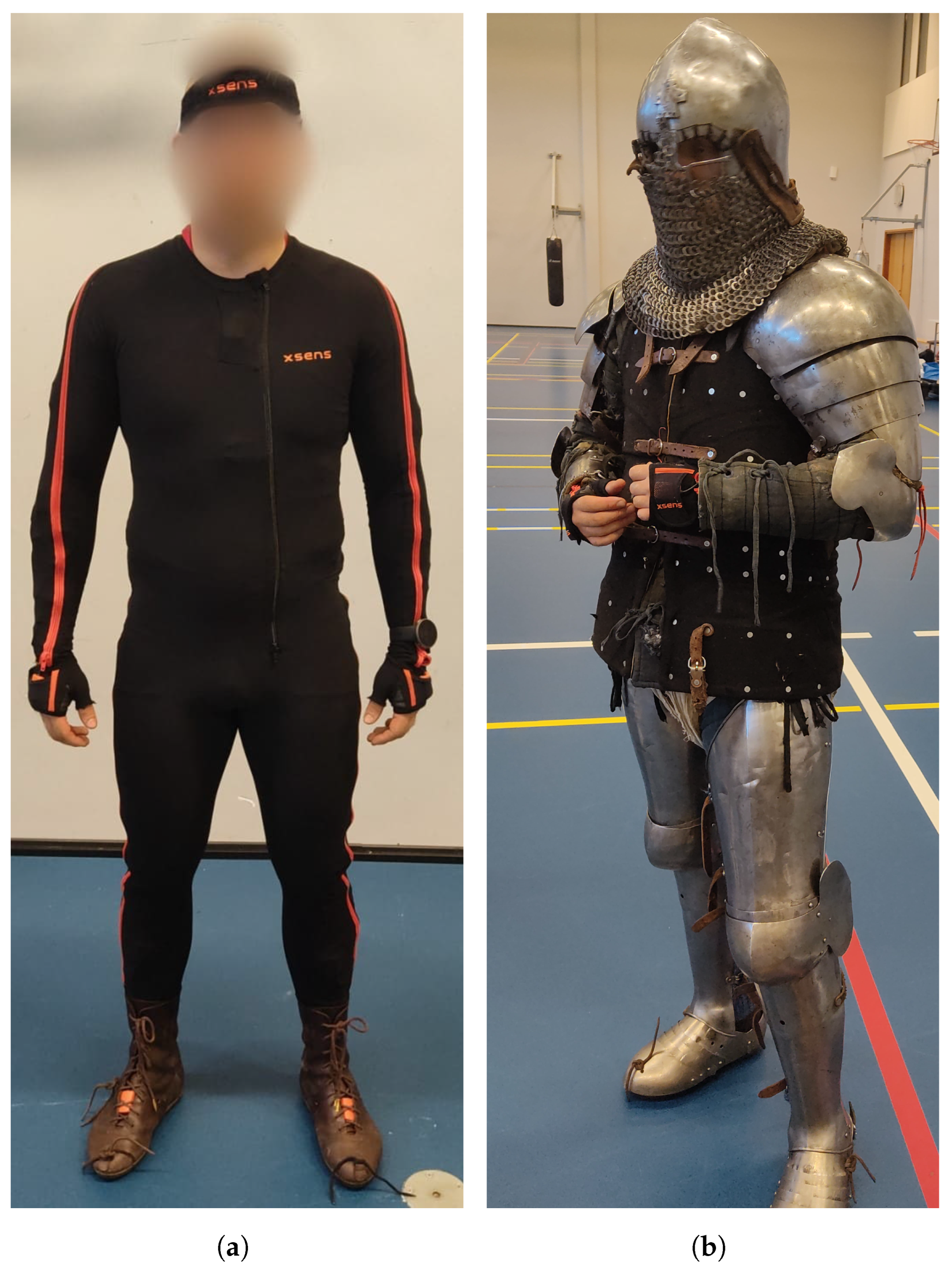
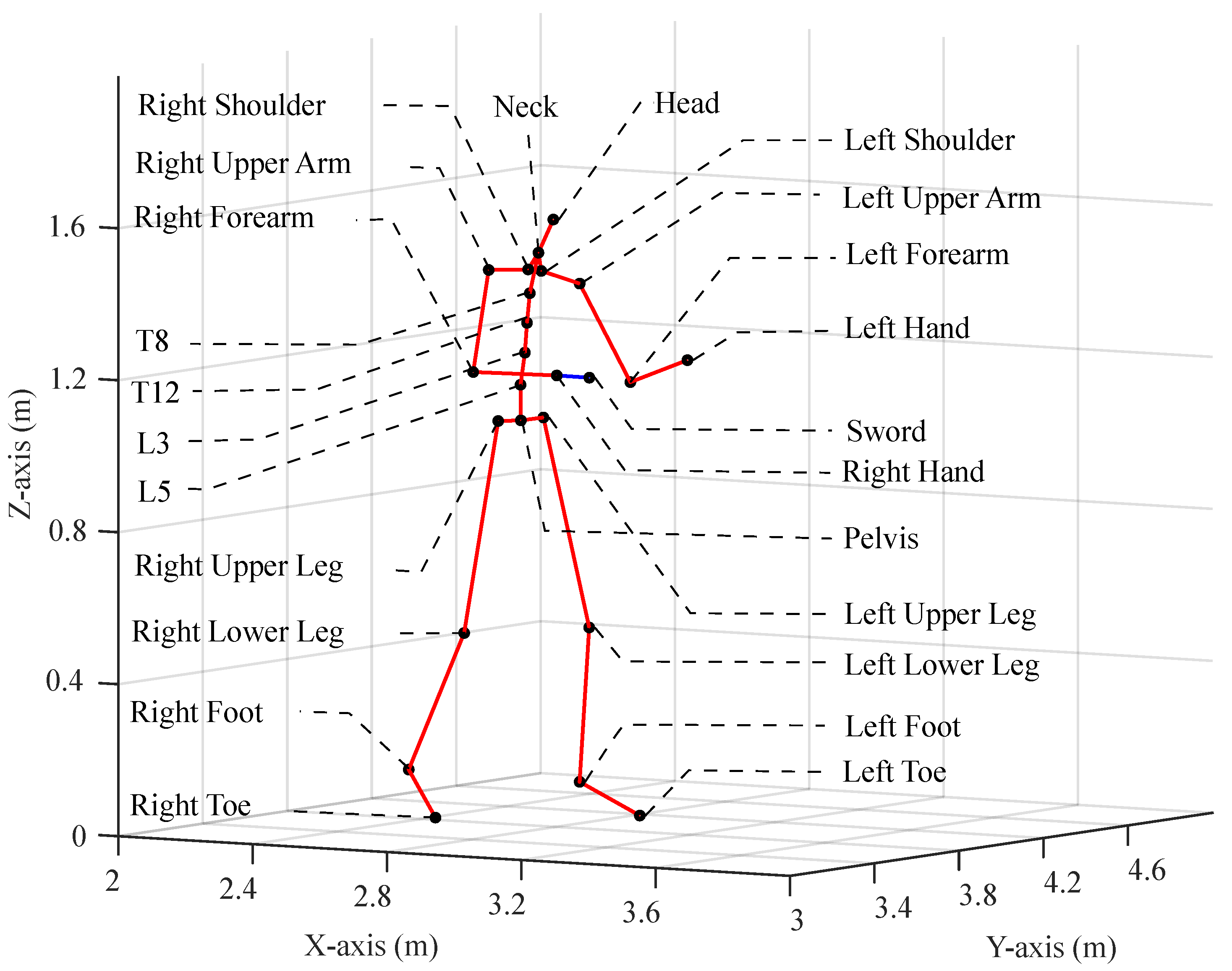
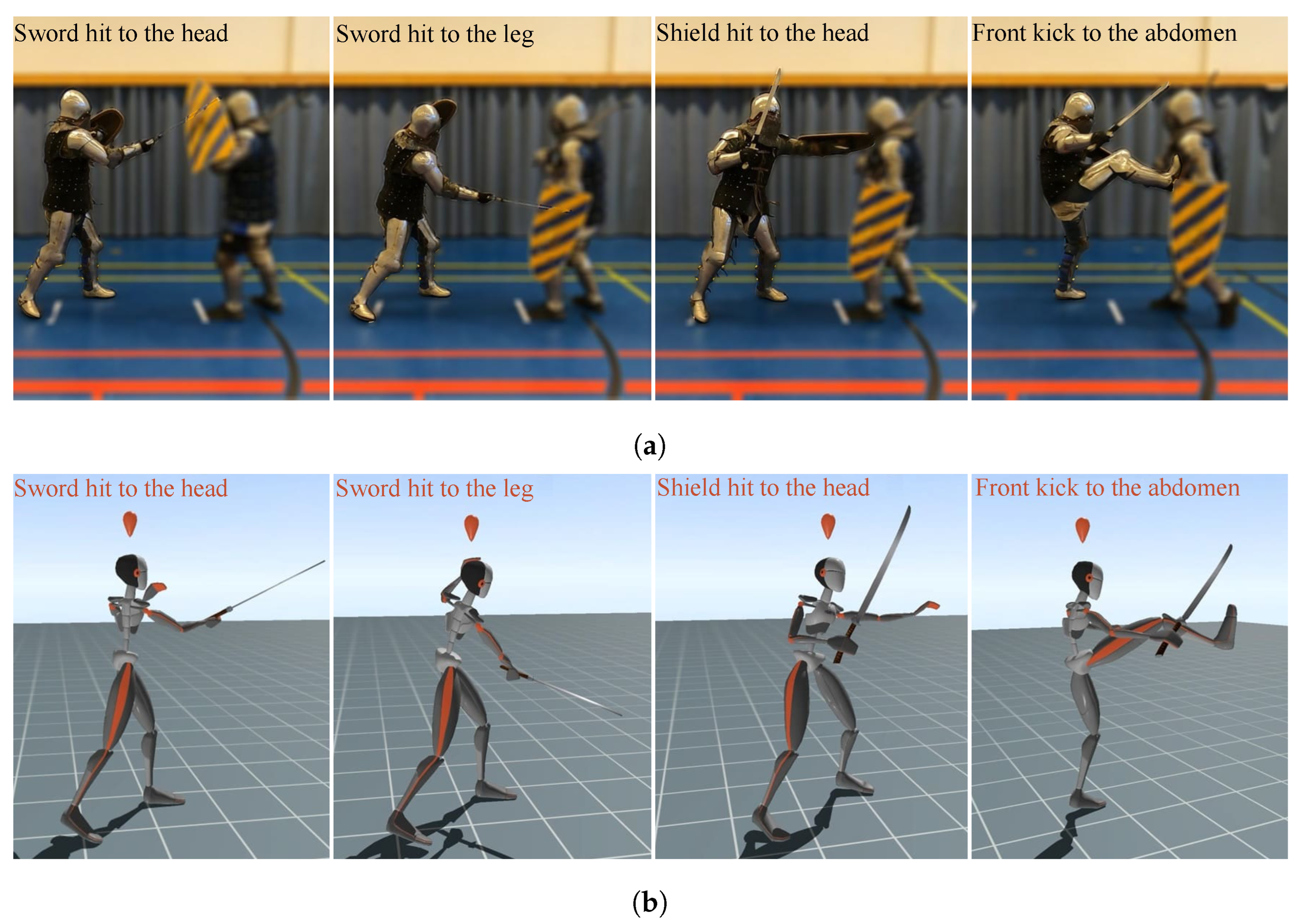

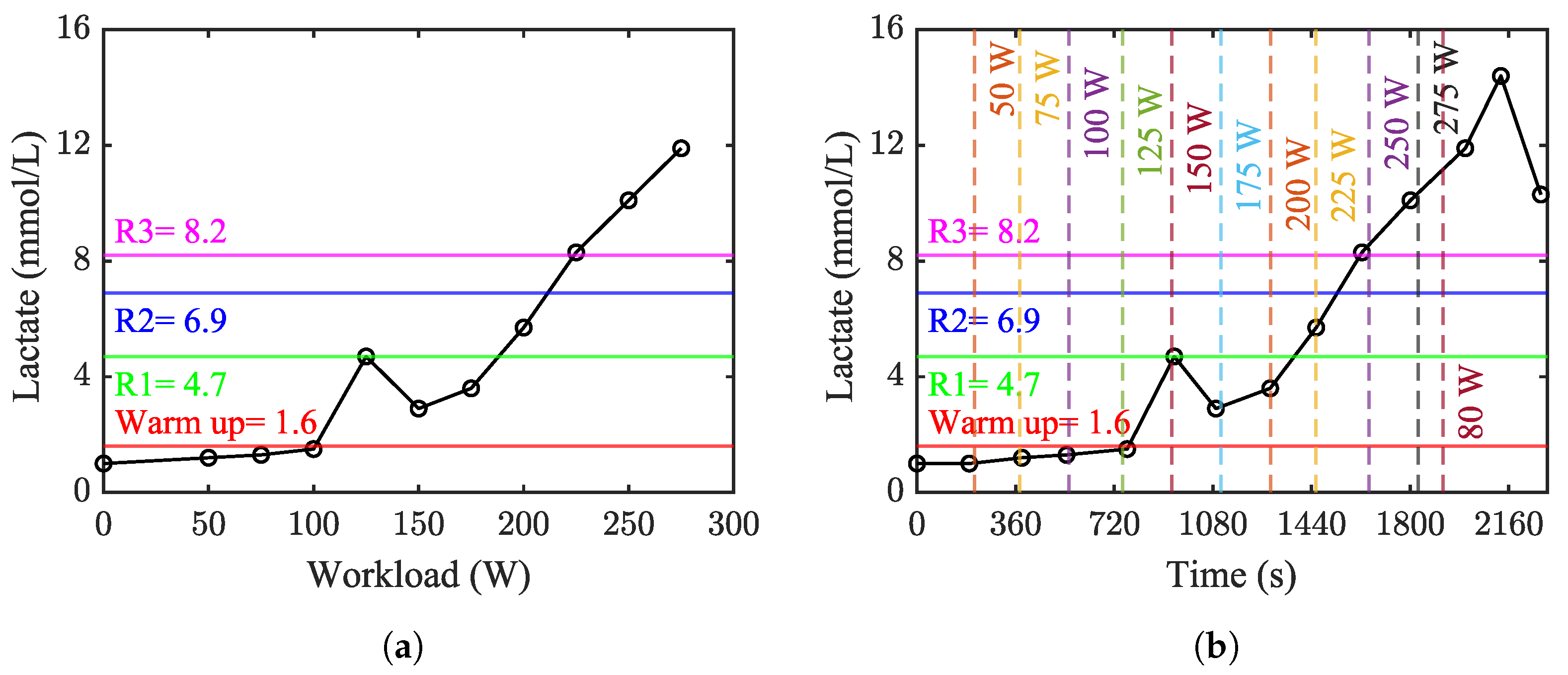
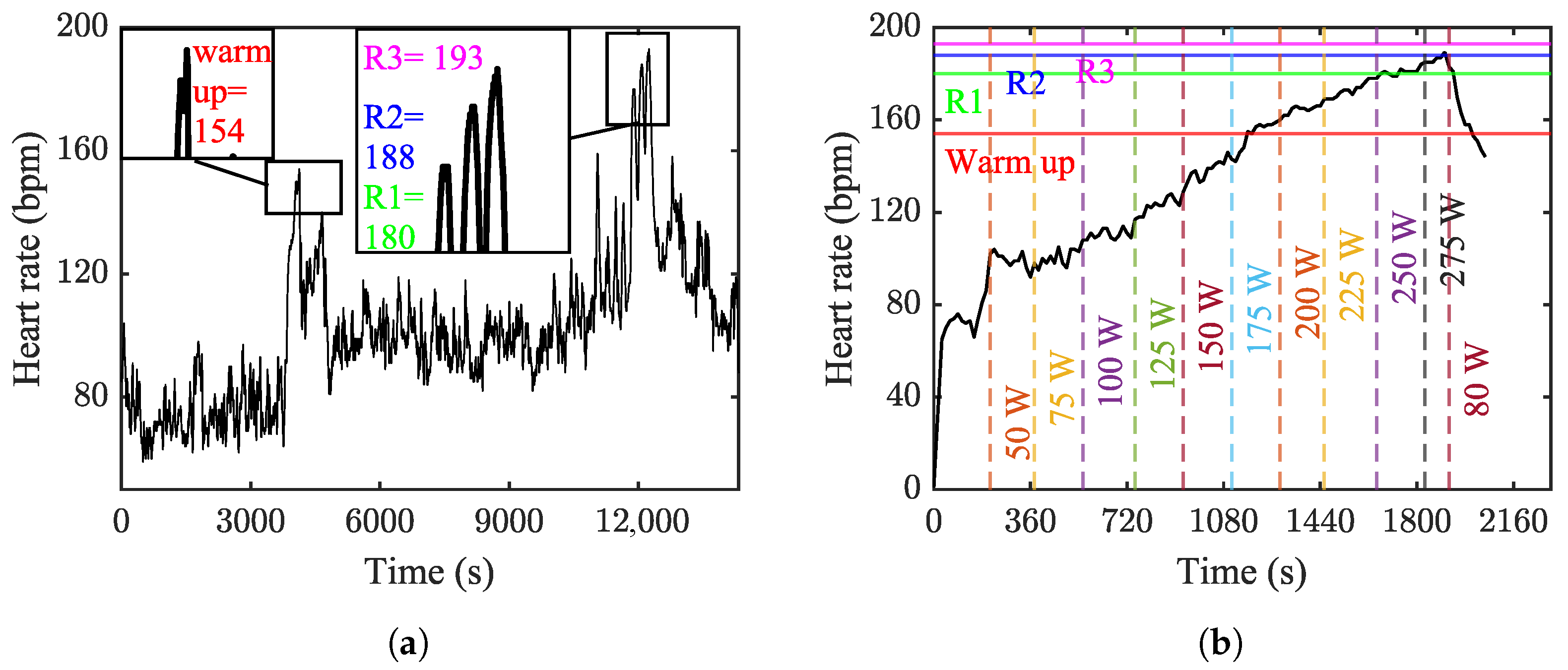
Disclaimer/Publisher’s Note: The statements, opinions and data contained in all publications are solely those of the individual author(s) and contributor(s) and not of MDPI and/or the editor(s). MDPI and/or the editor(s) disclaim responsibility for any injury to people or property resulting from any ideas, methods, instructions or products referred to in the content. |
© 2024 by the authors. Licensee MDPI, Basel, Switzerland. This article is an open access article distributed under the terms and conditions of the Creative Commons Attribution (CC BY) license (https://creativecommons.org/licenses/by/4.0/).
Share and Cite
Mohammadalizadeh, M.; Jaiswal, S.; Semken, S.; Mikkola, A. Kinematic and Physiological Analysis of Medieval Combat Sport Using Motion Analysis, Blood Lactate Measurement, and Heart Rate Monitoring: A Case Study. Sensors 2024, 24, 3443. https://doi.org/10.3390/s24113443
Mohammadalizadeh M, Jaiswal S, Semken S, Mikkola A. Kinematic and Physiological Analysis of Medieval Combat Sport Using Motion Analysis, Blood Lactate Measurement, and Heart Rate Monitoring: A Case Study. Sensors. 2024; 24(11):3443. https://doi.org/10.3390/s24113443
Chicago/Turabian StyleMohammadalizadeh, Mojtaba, Suraj Jaiswal, Scott Semken, and Aki Mikkola. 2024. "Kinematic and Physiological Analysis of Medieval Combat Sport Using Motion Analysis, Blood Lactate Measurement, and Heart Rate Monitoring: A Case Study" Sensors 24, no. 11: 3443. https://doi.org/10.3390/s24113443
APA StyleMohammadalizadeh, M., Jaiswal, S., Semken, S., & Mikkola, A. (2024). Kinematic and Physiological Analysis of Medieval Combat Sport Using Motion Analysis, Blood Lactate Measurement, and Heart Rate Monitoring: A Case Study. Sensors, 24(11), 3443. https://doi.org/10.3390/s24113443






